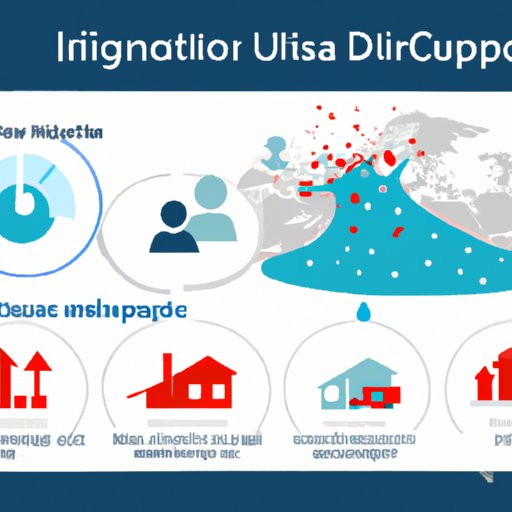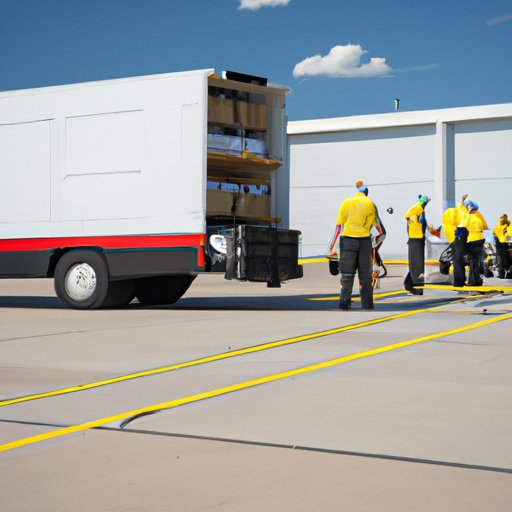I. Introduction
Disasters can strike at any time, leaving individuals and entire communities in need of emergency assistance. Disaster distribution is a critical part of emergency response efforts that ensures the efficient and effective delivery of essential resources to those in need. In this article, we will explore what disaster distribution is, how it works, and why it’s essential in emergency response efforts. Furthermore, we will discuss logistics, methods, challenges, innovations, and the impact of disaster distribution on the affected communities.
II. The Essential Guide to Disaster Distribution: What It Is and How It Works
Disaster distribution is the process of transporting, storing, and distributing essential resources to those in need during a disaster. The goal is to ensure that critical resources such as food, water, medicine, and shelter are delivered timely and efficiently to the affected individuals and communities.
Disaster distribution typically involves a coordinated effort with multiple parties, including government agencies, non-governmental organizations (NGOs), and private companies. Several factors contribute to the complexity of disaster distribution, including the type of disaster, the severity of the impact, and the geography of the affected area.
Components of disaster distribution typically include pre-positioning of resources, transportation, inventory management, and distribution to the impacted areas. It’s a complex operation with communication, coordination, and collaboration, which is crucial to its effectiveness.
III. The Role of Disaster Distribution: Why It’s Critical in Emergency Response Efforts
Disaster distribution is crucial in emergency response efforts because of the immediate needs that arise during and after a disaster. One of the critical objectives is to avoid food and water shortages, which can lead to illness, malnutrition, and even death. A well-executed disaster distribution plan can provide relief while preventing secondary disasters caused by resource shortages.
Several examples illustrate the critical role that disaster distribution plays in emergency situations. In 2010, Haiti experienced a terrible earthquake that left many people homeless and without food and water. Disaster distribution efforts from multiple organizations and countries facilitated the delivery of essential resources to those impacted areas. In 2005, Hurricane Katrina made landfall in New Orleans, causing widespread devastation and flooding. Disaster distribution efforts were critical in helping residents who had to evacuate and find shelter.
Effective disaster distribution efforts can have a significant impact on the affected communities. When resources are distributed efficiently and effectively, communities can get back on their feet faster. Individuals can concentrate on rebuilding their homes and businesses, instead of merely struggling to meet their basic needs.
IV. Behind the Scenes of Disaster Relief: Understanding the Logistics of Distribution
Disaster distribution is a complex logistical undertaking that involves several processes. The pre-positioning of resources is critical in ensuring the prompt response to the disaster in the area hit hard. Pre-positioning involves stockpiling resources in regional warehouses and staging centers to facilitate quick deployment.
The critical role of transportation in disaster distribution cannot be overstated. Transportation can involve various modes, including airplanes, helicopters, trucks, and boats, depending on the disaster’s type and geography. The allocation of resources during disaster distribution efforts is another critical consideration. Resource allocation should be proportional to the affected areas’ size, and there needs to be effective communication channels between the distribution centers and the impacted areas.
V. From Trucks to Tents: Exploring the Different Methods of Disaster Distribution
Disaster distribution can be achieved through various methods, each having its advantages and disadvantages. One of the most traditional methods of disaster distribution is using trucks and other vehicles to transport resources to the affected areas. A well-organized distribution center can facilitate the efficient loading and offloading of resources from the trucks.
Another method involves setting up disaster response tents in the affected area. Tents can serve as temporary shelters and distribution centers for resources. The use of tents can be an effective method for disasters that cause widespread displacement or those that require immediate shelter.
Other methods include the use of drones for search and rescue efforts, helicopter delivery of resources, and setting up of community kitchens for food distribution.
VI. The Challenges of Managing Disaster Distribution: Lessons Learned from Past Disasters
Disaster distribution is not without challenges, and many lessons have been learned from past experiences. One of the biggest challenges is the coordination of resources and communication between the various entities involved in disaster distribution. Lack of coordination can lead to duplication of efforts, missed opportunities, and inefficient resource allocation.
Additionally, the geography of the disaster-affected area can present logistical challenges to disaster distribution efforts. For instance, a disaster that occurs in a remote area with limited infrastructure can pose significant challenges to resource distribution efforts. The security of the distribution process can also be a challenge in areas with conflict or unrest.
However, many lessons have been learned from past disasters. A collaborative approach among stakeholders, streamlined communication channels, and efficient use of technological advances in the logistics processes have proven helpful in meeting these challenges.
VII. Innovations in Disaster Distribution: Using Technology to Improve Response Times
Technology has been a game-changer in disaster distribution. Information and communication technologies, such as satellite imagery, real-time tracking, and interactive maps, have been significant in improving response times and measurements, and improving the distribution process’s efficiency. Innovations such as 3D printing have the potential to revolutionize disaster distribution by enabling the on-site printing of essential items such as medical supplies, tools, and parts.
The use of social media has also proven useful in disaster distribution, with organizations leveraging platforms to share information and coordinate efforts.
As technology continues to advance, the future of disaster distribution appears bright. Advancements in robotics and automation could streamline and enhance the distribution process further.

VIII. The Impact of Disaster Distribution: How it Helps Communities Recover and Rebuild
Disaster distribution has a significant impact on the affected communities’ recovery and rebuilding process. When resources are distributed effectively and efficiently, it can reduce the burden on the affected individuals, allowing them to focus on other aspects of their recovery and rebuilding process.
Several stories of successful disaster distribution efforts illustrate how the impact can be felt on the ground. In 2017, a massive fire destroyed much of the Santa Rosa area in California. Disaster distribution efforts coordinated by the community and private industry provided relief to the affected individuals by distributing food, shelter, and other essentials. Hurricane Sandy, which hit the Northeast United States in 2012 had widespread damage, but disaster distribution helped those impacted rebuild and recover, in part because of the distributed resources.
Disaster distribution plays a critical role not only in immediate emergency response but also in the long-term recovery process of affected communities.
IX. Conclusion
In conclusion, disaster distribution is a critical part of emergency response efforts that plays a crucial role in ensuring affected communities receive the essential resources they need. This article provided insights into what disaster distribution is, how it works, and why it’s essential. We discussed logistics, methods, challenges, innovations, and the impact of disaster distribution on communities.
We learned that while it’s not without challenges, lessons learned from past disasters, such as improved communication and streamlined logistics processes, have led to enhanced disaster distribution efforts. Lastly, we call upon all readers to support disaster distribution efforts in any way they can, including donating resources and volunteering.
